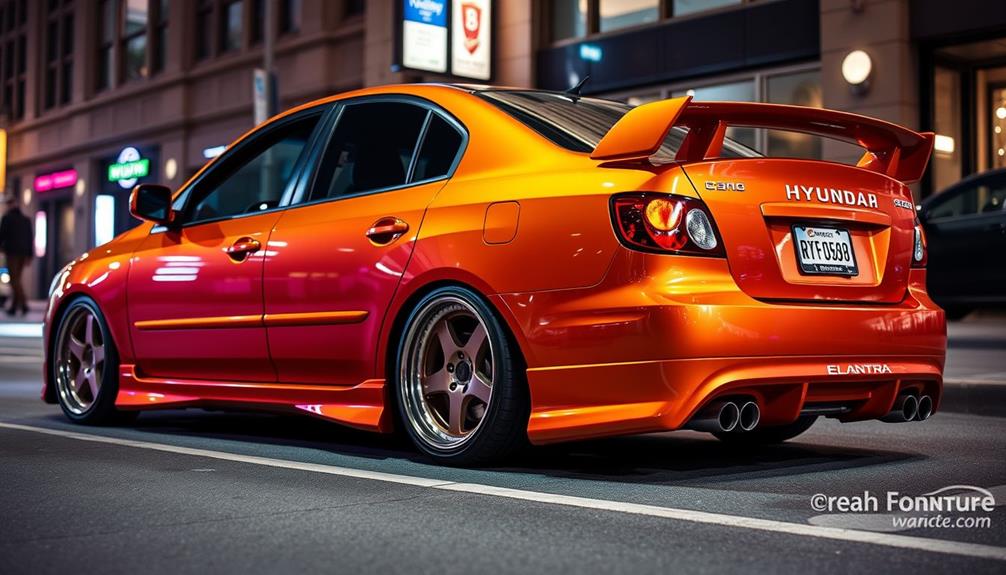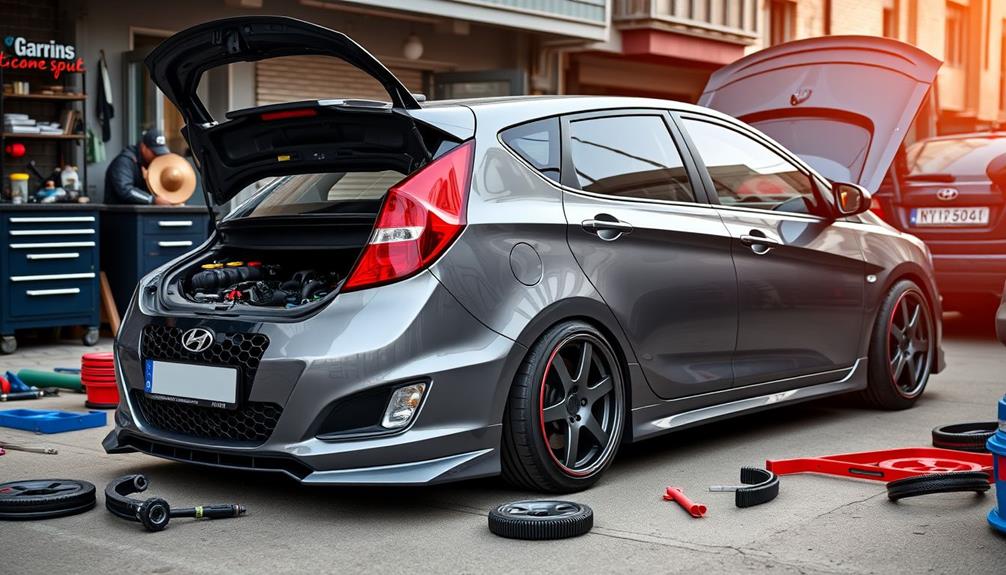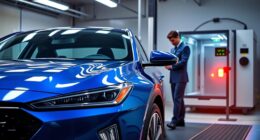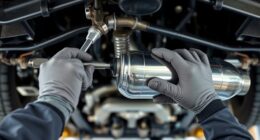Tuning your 2007 Hyundai Sonata can turn it into an exciting performance powerhouse. Start with basic upgrades like a cold air intake and an aftermarket exhaust system to boost horsepower. Consider an ECU remap to optimize engine performance further. If you're looking for a more spirited ride, adding adjustable coilovers will enhance handling and cornering stability. Don't forget about the community insights—many enthusiasts report significant gains with these tweaks! Careful planning and budgeting can guarantee you get the best value for your investments. Stick around, and you'll uncover more tips for maximizing your Sonata's potential.
Key Takeaways
- Upgrade to a cold air intake system for potential horsepower gains exceeding 20 hp and improved engine responsiveness.
- Consider performance exhaust systems to reduce backpressure, enhancing power output by 5-15 hp and improving sound.
- Implement an ECU remap or performance tune to optimize the air-fuel mixture for additional 10-20 hp increases.
- Install high-performance suspension with adjustable coilovers to enhance handling, stability, and cornering performance.
- Engage with tuning communities for insights and recommendations on modifications, ensuring well-informed decision-making.
Engine Specifications and Performance
When it comes to tuning your 2007 Hyundai Sonata, understanding its engine specifications and performance capabilities is essential.
You've got two engine options: the standard 2.4-liter inline-4, producing 162 horsepower and 164 lb-ft of torque, or the more powerful 3.3-liter V6, which cranks out 249 horsepower and 229 lb-ft of torque.
Both engines provide a solid foundation for engine tuning and performance enhancements.
If you're aiming for more power, consider modifications like a cold-air intake and a cat-back exhaust system.
These upgrades can greatly enhance airflow, potentially adding 10-20 horsepower to your Sonata.
While the engine is designed for regular 87 octane fuel, using a higher octane can optimize performance, especially when paired with aftermarket tuning solutions.
The Sonata's drivetrain supports a range of tuning modifications, offering considerable performance upgrades without sacrificing daily drivability.
Whether you stick with the inline-4 or opt for the V6, you can achieve impressive results by focusing on these engine tuning options and performance enhancements.
Your Sonata can easily transform into a more spirited ride with the right modifications.
Boost Modification Considerations

Boost modifications can greatly enhance the performance of your 2007 Hyundai Sonata, but they come with important factors to weigh. Increasing boost levels may void your powertrain warranty and require significant drivetrain modifications to avoid engine damage.
You'll also need to evaluate fuel requirements. While stock engines run on 87 octane, higher octane fuel becomes necessary after modifications for peak performance and to prevent knocking. Turbo ECU systems can adjust for fuel type, giving you an approximate gain of 10 additional horsepower when using premium fuel. Utilizing a manual boost controller can effectively increase engine boost, but be cautious—without proper management, you might face ECU de-tuning issues.
To reach impressive performance levels, like 500 hp, significant modifications such as a full 3.5 intake and turbo-back exhaust systems are essential.
| Factor | Impact on Performance | Required Action |
|---|---|---|
| Boost Level Increase | Higher horsepower potential | Upgrade performance parts |
| Fuel Octane Requirement | Prevents engine knocking | Switch to premium fuel |
| Turbo ECU Adjustments | Peak power output | Reprogram ECU if needed |
| Manual Boost Controller | Increased boost capability | Monitor ECU settings |
| Exhaust System Upgrade | Essential for airflow | Install turbo-back system |
Performance Modifications Overview

For enthusiasts looking to elevate their 2007 Hyundai Sonata's performance, a variety of modifications can greatly enhance both power and handling.
One of the first steps you can take is upgrading to a performance intake system, which increases airflow and can boost horsepower by 10-20 hp while improving throttle response.
Next, consider installing a cat-back exhaust system; this modification reduces backpressure and can add another 5-15 hp, all while giving your Sonata a more aggressive exhaust note that enhances your driving experience.
Additionally, utilizing a performance tune or ECU reflash can optimize your air-fuel mixture and ignition timing, yielding another 10-20 hp—especially effective when combined with other upgrades.
To further improve handling, adding a high-performance suspension system with adjustable coilovers will enhance cornering stability, making your Sonata more responsive during spirited drives.
Community Insights and Feedback

As you explore tuning your 2007 Hyundai Sonata, you'll find a wealth of user experiences and recommendations in community forums.
Many enthusiasts share their favorite modifications and how those changes align with their performance goals.
Engaging in these discussions can help you make informed choices and connect with others who share your passion for enhancing your ride.
User Experiences Shared
While many Hyundai Sonata owners have embraced tuning modifications, their experiences share a common thread of satisfaction stemming from enhanced performance. Users frequently report significant horsepower gains after installing cold air intakes and exhaust systems. These aftermarket parts not only boost engine output but also elevate the overall driving experience.
Many enthusiasts note that after their modifications, switching to high-octane fuel can yield an additional 10 horsepower, ensuring they get the most out of their upgrades. Community feedback often emphasizes the positive impact of tuning modules, with users experiencing improved responsiveness and fuel efficiency, leading to gains of 10-15 extra horsepower.
Engaging with fellow owners online helps newcomers navigate the world of tuning solutions, as shared insights can direct them toward effective modifications and reliable products. However, it's important to take into account the mixed opinions on potential risks.
Some users caution about the possibility of voiding warranties, while others focus on the sheer enjoyment and performance benefits that come from proper tuning. Ultimately, your journey into Hyundai Sonata tuning can be rewarding, filled with increased power and a vibrant community ready to share their experiences.
Modification Recommendations Exchange
Engaging with fellow enthusiasts in online forums can greatly enhance your tuning journey. These communities foster a collaborative learning environment where you can exchange modification recommendations and experiences. By tapping into the collective knowledge of other Hyundai Sonata owners, you can considerably improve your vehicle's performance.
Here are some popular modification recommendations that many users have found beneficial:
- Cold Air Intakes: Users report horsepower gains exceeding 20, making it a must-try.
- Performance Exhaust Systems: Enjoy better sound and increased power output with this modification.
- Tuning Modules: Explore reliable options shared by community members to optimize engine efficiency.
- Documentation: Keep a record of your tuning process and share it, helping both yourself and others.
Community feedback highlights the importance of understanding your vehicle's limits before pursuing any upgrades. Researching thoroughly guarantees your modifications align with your expectations.
Performance Goals Alignment
Many enthusiasts emphasize the importance of aligning your performance goals with the Hyundai Sonata's capabilities to guarantee a satisfying tuning experience. Understanding the engine's limits is essential; many users suggest making gradual modifications that boost performance without sacrificing reliability.
A balanced approach is often recommended, focusing on both increased horsepower and preserving fuel efficiency. To achieve realistic horsepower gains, consider integrating power tune modules alongside intake and exhaust upgrades. Many community members report gains of 10-15 hp just from tuning modules, enhancing your driving experience considerably.
However, thorough research on tuning options is imperative. Proper installation and choosing reputable brands can help prevent potential engine strain or warranty issues. Engaging with fellow enthusiasts can provide valuable insights, making sure your modifications align with the Sonata's strengths.
Cost and Value Analysis

When pondering performance modifications for your 2007 Hyundai Sonata, it's important to weigh the costs against the potential benefits. The cost and value analysis will guide your decisions, especially given that performance mods can range from $300 to $800 just for tuning modules.
Additional expenses for installation and parts can greatly escalate your total investment.
However, many Sonata owners discover that enhanced performance often leads to improved fuel efficiency, which can help offset some of those initial costs over time.
Here are a few points to reflect on:
- The Sonata's competitive pricing (typically under $30K) makes it a valuable option for upgrades.
- Horsepower gains from aftermarket parts can vary based on your budget and performance goals.
- Community insights can provide guidance, helping you make informed decisions.
- Evaluating cost vs. performance is vital to maximizing your return on investment.
Ultimately, a well-planned approach to tuning can transform your Sonata into a performance powerhouse while still being mindful of your budget.
Tuning Stages and Options

When tuning your 2007 Hyundai Sonata, you'll encounter several stages, each offering unique performance modifications.
Stage 1 might boost your horsepower with simple ECU remaps and exhaust upgrades, while Stage 3 could require extensive engine work for serious gains.
You'll also need to decide between DIY tuning or seeking professional help to guarantee you get the best results without compromising reliability.
Engine Tuning Stages Explained
Understanding the different engine tuning stages is vital for maximizing your 2007 Hyundai Sonata's performance. Each stage builds on the last, allowing you to enhance your vehicle gradually without overwhelming it.
Here's a breakdown of the tuning stages:
- Stage 1: Focuses on basic upgrades like remapping the ECU, installing a sports exhaust, and upgrading the suspension for better handling.
- Stage 2: Involves more significant modifications, such as ported heads, upgraded fuel pumps, and high-flow injectors to boost horsepower and torque while keeping daily drivability.
- Stage 3: Requires extensive changes, including forced induction upgrades and internal engine modifications. This stage is tailored for competition, not your daily commute.
- Tuning adjustments: Proper tuning and fueling modifications are essential at every level to avoid overheating and strain on your engine, ensuring reliability as you enhance performance.
Performance Modifications Overview
After exploring the different engine tuning stages, it's clear that performance modifications can greatly enhance your 2007 Hyundai Sonata.
Starting with Stage 1, consider remapping the ECU, upgrading to lighter alloy wheels, and installing a sports exhaust. These changes improve handling and drivability while giving your car a sportier feel.
For those looking to push further, Stage 2 upgrades like porting the head, upgrading the fuel pump, and adding high-flow injectors can considerably boost engine performance.
You'll notice a marked increase in stopping power and acceleration.
If you're ready for the ultimate transformation, Stage 3 enhancements involve more extensive upgrades like forced induction and internal engine modifications.
While these tweaks can elevate power output to impressive levels, keep in mind they might affect daily drivability.
As you think about your performance modifications, remember that achieving a balanced torque band is essential for maintaining reliability.
It's not just about peak power; you want to make sure your Sonata remains practical for everyday use while enjoying the thrill of enhanced performance.
DIY Vs. Professional Tuning
Tuning your 2007 Hyundai Sonata can be an exciting journey, whether you're a DIY enthusiast or prefer to leave it to the professionals. There are several ways to enhance the performance and appearance of your 2007 Hyundai Sonata. From installing a new exhaust system or air intake to upgrading the suspension and brakes, there are plenty of options to consider. Additionally, modern upgrades for your Hyundai Sonata, such as a touchscreen infotainment system or LED headlights, can also improve your driving experience and give your car a more contemporary look. Whether you choose to do the upgrades yourself or have a professional handle it, there are plenty of options to take your Sonata to the next level.
Each option has its advantages, and understanding the differences can help you make the right choice for your performance goals.
DIY tuning typically involves Stage 1 modifications, which include:
- Remapping the ECU for better performance
- Installing a sports exhaust for enhanced sound and airflow
- Upgrading the intake system for increased efficiency
- Cost-effective solutions ranging from $80 to $800
On the other hand, professional tuning offers extensive upgrades.
This includes Stage 2 and Stage 3 modifications involving:
- Internal engine work for significant power gains
- Forced induction upgrades for maximum performance
- Advanced ECU recalibration to optimize your setup
- Higher overall costs, often reflecting labor and premium parts
While DIY tuning can provide a good initial boost of 10-15 horsepower, professional tuning can release even greater potential.
Remember to weigh factors like warranty implications and the need for proper installation to prevent engine strain or overheating.
Choose the path that aligns best with your skills, budget, and performance aspirations!
Suspension and Handling Enhancements

When it comes to enhancing the suspension and handling of your 2007 Hyundai Sonata, upgrading to adjustable coilovers can make a world of difference. These coilovers allow you to personalize your ride height, improving both ride quality and cornering stability.
Lowering the suspension by 22mm to 42mm can greatly boost your Sonata's road holding capabilities, though keep in mind that larger drops may require additional modifications to avoid rubbing.
To optimize cornering performance, aim for a front toe setting of 0.8 to 1.3 degrees. This small adjustment can drastically enhance your overall driving dynamics.
Installing performance struts and shocks is another great way to increase responsiveness and reduce body roll during aggressive driving, giving you that sportier feel you crave.
Additionally, reinforcing the chassis with strut tower braces will improve rigidity, leading to better handling and stability, especially during high-speed cornering.
Intake and Exhaust Upgrades

One of the most effective ways to boost your 2007 Hyundai Sonata's performance is by upgrading the intake and exhaust systems.
By investing in these intake and exhaust upgrades, you can considerably improve your engine's efficiency and power.
Here are some key benefits of these upgrades:
- Cold Air Intake: An aftermarket cold air intake system enhances airflow, leading to improved combustion and potential horsepower gains of 20+ hp.
- Sports Exhaust System: This type of exhaust system reduces backpressure, optimizing exhaust flow for increased horsepower and a more aggressive sound.
- Proper Pipe Sizing: For the Sonata, a 2.5-inch exhaust pipe size is ideal. Oversized pipes might hinder performance instead of enhancing it.
- ECU Remap: Pairing these upgrades with an ECU remap maximizes overall engine performance, ensuring efficient operation under increased airflow conditions.
These modifications not only improve your Sonata's power output but can also enhance fuel efficiency, especially on the highway.
With the right intake and exhaust upgrades, you'll transform your sedan into a true performance powerhouse.
Frequently Asked Questions
Can You Modify a Sonata?
Yes, you can modify a Sonata. Consider upgrading parts like the intake and exhaust for better performance. Just make certain your modifications align with your vehicle's components and be mindful of warranty and insurance implications.
Can You Put a V6 in a Hyundai Sonata?
Imagine your Sonata roaring to life as you swap in a V6. Yes, you can! With some modifications to mounts and wiring, you'll release a thrilling surge of horsepower and torque beneath your foot.
What Is the Most Powerful Hyundai Sonata?
The most powerful Hyundai Sonata is the 2015 Sonata 2.0T, boasting 275 hp. With tuning and aftermarket modifications, you can unleash even more potential, pushing performance figures to impressive levels for an exhilarating driving experience.
When Should a Hyundai Sonata Get a Tune Up?
Like a clock ticking, your Hyundai Sonata needs a tune-up every 30,000 to 60,000 miles. Watch for signs like rough idling or poor fuel efficiency, and keep your engine running smoothly and efficiently.
Conclusion
In tuning your 2007 Hyundai Sonata, you're not just upgrading a sedan; you're revealing its hidden potential. While some might think a factory car can't compete with performance models, the right modifications can transform your ride into a thrilling powerhouse. Remember, it's about balancing power and handling. Engaging with fellow enthusiasts can reveal invaluable tips and tricks, helping you avoid common pitfalls. So, immerse yourself and enjoy the journey of enhancing your Sonata—it's worth the ride!










